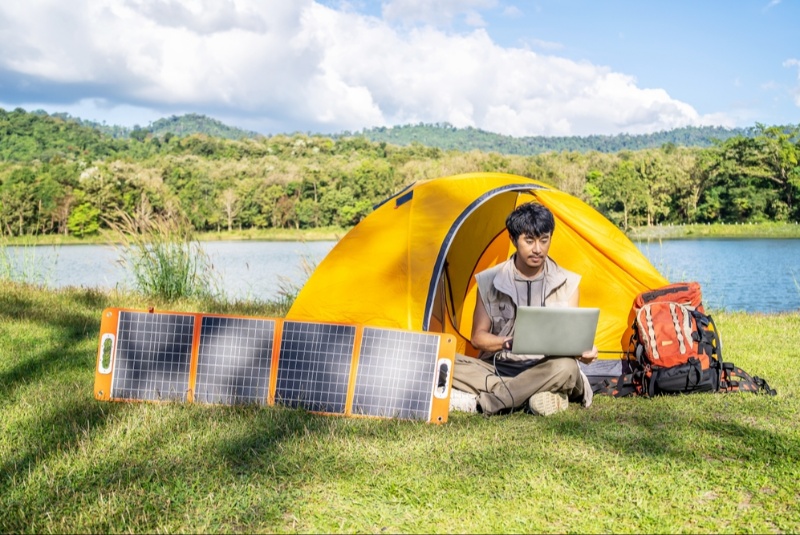Summer camping trips offer the perfect escape into nature, but staying connected and powered up is essential for safety and convenience. Solar chargers provide a sustainable solution, harnessing the sun's energy to keep devices charged. This guide explores key factors to consider when choosing the best solar charger for your summer camping needs.
Understanding Solar Charger Types
When choosing a solar charger, understanding the different types available can significantly influence your decision. Fixed solar panels are robust and highly efficient, ideal for campers who stay in one location and can afford the space and weight. These are best for powering multiple devices or when camping in areas with limited sunlight. Foldable panels, on the other hand, offer the convenience of portability and are designed for the on-the-go adventurer. They can easily fit into a backpack and are lighter, though they may offer slightly less power output. Solar power banks combine the utility of a battery pack with a solar panel, providing power even when the sun has set, though the solar charging can be slower. Understanding these types ensures you pick one that aligns with your camping style and power needs.
Power Output and Efficiency
The power output of your solar charger, measured in watts (W), directly affects its charging capabilities. A higher wattage means more power, allowing you to charge devices more quickly. Efficiency is another critical factor; it determines how well the charger converts sunlight into electrical energy. Look for a charger with an efficiency rate of 20% or higher for the best performance. It's essential to match the charger's output and efficiency with your devices' requirements. A charger with at least 10W to 15W is a good starting point for smartphones, but tablets and other larger devices might need more power.

Durability and Weather Resistance
For outdoor activities like camping, the durability and weather resistance of your solar charger are paramount. Opt for chargers crafted from rugged materials that can withstand the rigors of outdoor use, including exposure to dust, rain, and occasional drops or falls. Features such as waterproofing or water resistance (look for IPX ratings) and UV-resistant materials will ensure your charger stands up to the elements. Durable chargers are more likely to last longer, providing better value for your investment and ensuring you're not left without power when you need it most.
Portability and Ease of Use
A solar charger's weight and design impact its portability, a crucial factor for campers and hikers. Lightweight and compact models are preferred for backpacking, where every ounce counts. Foldable or rollable solar panels are excellent for saving space, and some come with carabiners or straps for easy attachment to backpacks or tents. Ease of use is also important; choose chargers with straightforward setups and minimal maintenance requirements. Features like built-in stands or tilt mechanisms can help maximize sun exposure, improving efficiency without constant supervision.
Compatibility and Connectivity
The best solar charger is one that's compatible with all your devices. Most chargers come with USB ports, but the number and type (such as USB-A, USB-C) can vary. Consider the input requirements of your devices, including smartphones, GPS units, cameras, and if you'll need to charge multiple gadgets simultaneously. Some solar chargers offer additional connectivity options like direct DC outputs or special adapters for devices like cameras or laptops, providing a versatile charging solution for all your tech needs.
Charge Storage Options
Having a solar charger with charge storage capability, either through an integrated battery or compatibility with external power banks, ensures you have power whenever you need it. Integrated battery models can store charge during sunny conditions for use at night or on cloudy days. When choosing a charger with storage, pay attention to the battery's capacity (measured in milliampere-hours, mAh) to ensure it meets your charging needs. External power banks can offer more flexibility and higher capacity, but they require managing another device.
Price Versus Performance
While it's tempting to opt for the cheapest option, investing in a solar charger that offers a balance between price and performance can lead to better satisfaction and reliability in the long run. High-quality materials, efficient solar panels, and additional features like water resistance and integrated batteries often come at a higher cost but can significantly enhance your camping experience. Consider your specific needs, how often you'll use the charger, and which features are most important to you to find the best value.
Reading Reviews and Seeking Recommendations
Leveraging the experiences of others can guide you to the best solar charger for your needs. Online reviews, camping forums, and recommendations from friends or outdoor enthusiasts offer insights into a charger's real-world performance, durability, and ease of use. Pay attention to comments about how the charger performs in various weather conditions, its real-life efficiency, and any issues users have encountered. This research can help you identify reliable models and avoid those that might not meet expectations.
Selecting the right solar charger for your summer camping adventures requires careful consideration of various factors, from the types of chargers available to their power output, durability, and compatibility with your devices. By assessing your needs, doing thorough research, and possibly investing a bit more for quality, you can find a solar charger that reliably supports your outdoor activities. The ideal solar charger not only keeps your devices powered up but also contributes to a more sustainable and enjoyable camping experience.




